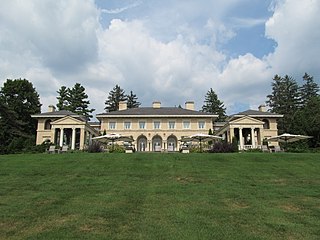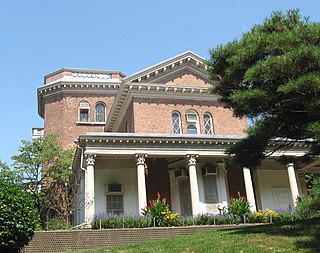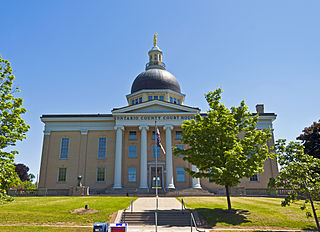
The Mathias Ham House is a 19th-century house in Dubuque, Iowa that is on the National Register of Historic Places. It is located at the intersection of Shiras and Lincoln Avenues, near the entrances to Eagle Point Park and Riverview Park.

The Mohonk Mountain House, also known as Lake Mohonk Mountain House, is an American resort hotel located on the Shawangunk Ridge in Ulster County, New York. Its location in the town of New Paltz, New York is just beyond the southern border of the Catskill Mountains, west of the Hudson River.

Friendship Hill was the home of early American politician and statesman Albert Gallatin (1761–1849). Gallatin was a U.S. Congressman, the longest-serving Secretary of the Treasury under two presidents, and ambassador to France and Great Britain. The house overlooks the Monongahela River near Point Marion, Pennsylvania, about 50 miles (80 km) south of Pittsburgh.

Black Point is an estate on the south shore of Geneva Lake in Wisconsin, United States, built in 1888 as a summer home by Conrad Seipp, a beer tycoon from Chicago. It has also been known as Conrad and Catherine Seipp Summer House and as Die Loreley

The Villa Louis is a National Historic Landmark located on St. Feriole Island, in Prairie du Chien, southwestern Wisconsin. The villa and estate are a historical museum operated by the Wisconsin Historical Society. The site has been restored to its appearance during the late 19th century, when it was the estate of the prominent H. Louis Dousman family, descendants of a fur trader and entrepreneur.

The Isaac Bell House is a historic house and National Historic Landmark at 70 Perry Street in Newport, Rhode Island. Also known as Edna Villa, it is one of the outstanding examples of Shingle Style architecture in the United States. It was designed by McKim, Mead, and White, and built during the Gilded Age, when Newport was the summer resort of choice for America's wealthiest families.

Wheatleigh is a historic country estate on West Hawthorne Road in Stockbridge, Massachusetts, United States. Built in 1893 to a design by Peabody and Stearns, it is one of the few surviving great Berkshire Cottages of the late 19th century, with grounds landscaped by Frederick Law Olmsted. Its estate now reduced to 22 acres (8.9 ha), Wheatleigh was listed on the National Register of Historic Places in 1982. It is now operated as a hotel.

Joel Chandler Harris House, also known as The Wren's Nest or Snap Bean Farm, is a Queen Anne style house at 1050 Ralph D. Abernathy Blvd., SW. in Atlanta, Georgia. Built in 1870, it was home to Joel Chandler Harris, editor of the Atlanta Constitution and author of the Uncle Remus Tales, from 1881 until his death in 1908. He is most known as author of the "Uncle Remus" tales, based upon stories he heard slaves tell during his youth.

Litchfield Villa, or "Grace Hill", is an Italianate mansion built in 1854–1857 on a large private estate now located in Prospect Park, Brooklyn, New York City. It is located on Prospect Park West at 5th Street. The villa was designed by Alexander Jackson Davis, America's leading architect of the fashionable Italianate style for railroad and real estate developer Edwin Clark Litchfield.

Osborne House is a historic home located at Victor in Ontario County, New York, USA. It is a two story with full attic Italian Villa style dwelling built about 1855. Surmounting the hip roof is a notable cupola. Contributing structures on the property are a carriage barn, smokehouse, corn crib, and chicken house.

Parrott Hall is a historic home located at Geneva in Ontario County, New York. It was built in the early 1850s and consists of a 3-story main block and 2-story addition in the Italianate villa style. In 1882, the property was acquired by New York State for use as an agricultural experiment station, and was part of the New York State Agricultural Experiment Station until 1968. It was deeded to the New York State Office of Parks, Recreation and Historic Preservation in 1970 for use as a museum.

Simon Ritter Cobblestone Farmhouse is a historic home located at Varick in Seneca County, New York. It is a late Federal / early Greek Revival style, cobblestone farmhouse with an overlay of Italianate detailing. It is a two-story, slightly asymmetrical structure, on a raised fieldstone foundation. It was built about 1830 and is constructed of irregularly sized and variously colored field cobbles. The house is among the approximately 18 surviving cobblestone buildings in Seneca County. Also on the property are two large early / mid 19th century barns, a carriage house and machine shed, a boathouse built about 1900 on the shore of Cayuga Lake, and a limestone carriage stepping stone.

Queen's Castle, also known as Camp Fossenvue or simply Fossenvue ), is the remnant of a historic camp located at Lodi in Seneca County, New York. It is a rustic, lakeside camp structure built about 1881 on the shore of Seneca Lake. It is a one-story, roughly square, 17 feet, 6 inches by 18 feet, structure surmounted by a steeply pitched wood shingled hipped roof. It is the sole surviving component of Camp Fossenvue, established in 1875 as an informal, lakeside summer retreat for liberally minded young women could indulge in a variety of radical, even scandalous, intellectual, physical, and recreational activities. Its last year of operation as a women's camp was in 1901. In 1924, the site was sold to the Elmira Council of Boy Scouts for Camp Seneca, which continued to operate until 1989. The United States Department of Agriculture purchased the property in 1996, adding it to the Finger Lakes National Forest.

Blue Mountain House Annex, also known as The Log Hotel, is a historic hotel located on the grounds of the Adirondack Museum at Blue Mountain Lake in Hamilton County, New York. It was built in 1876 and is a two-story structure built of square-hewn spruce logs with halved log cornering. It features a verandah on the south and east. It is one of the earliest and best known of the Adirondack resort hotels.

The Hedges is a historic home and Adirondack Great Camp located at Blue Mountain Lake in Hamilton County, New York. The property consists of 30 buildings and structures and many related site features. From about 1890 to 1920, it was the seasonal home of Hiram B. Duryea, and from this period nine buildings and structures remain. In 1920, it was purchased by Richard J. Collins and converted to an Adirondack resort. The Main Lodge complex was built in 1882; the main block is a two-story, wood-framed building with a mansard roof. The Stone Lodge was built 1900–03 and is a two-story gambrel-roofed building.

The Gifford–Davidson House, also known as Stone Cottage, in Elgin, Illinois was built in 1850 and expanded in 1871. The Gifford–Davidson House is unusual due to its cobblestone construction and Second Empire style details. This design would have been more typical in James Gifford's original home of New York City. It was individually listed on the National Register of Historic Places (NRHP) in 1980. Also, it is a contributing property in the Elgin Historic District, which was listed on the NRHP in 1983.

George W. Denton House is a historic home located at Flower Hill in Nassau County, New York. It was built in 1873 and is a rectangular, 2-story wood frame building with a two-stage rear service ell in a vernacular Italian Villa style. It features a 2 1⁄2-story engaged tower, semi-octagonal bay windows, and an "L" shaped wraparound verandah. Also on the property is a brick ice house built into the side of a hill.

The Starling Childs Camp is a historic cottage on the south shore of Doolittle Lake in Norfolk, Connecticut. Built in 1923, it is significant as an idiosyncratic design of architect Alfredo S.G. Taylor. It was listed on the U.S. National Register of Historic Places in 1982, for its association with the architect.

Kelly's Camp is a small district of vacation cabins on the west shore of Lake McDonald in Glacier National Park, Montana, USA. Kelly's Camp consists of twelve log buildings along the western shore of the lake. The structures were notable for being one of the most extensive summer cabin enclaves remaining in the park. Early reports following the advance of the Howe Ridge Fire on August 12, 2018 are that nine or ten structures have been destroyed.

Fox Hall is a historic summer estate house in Westmore, Vermont. Built about 1900 by the then-mayor of Yonkers, New York, it was the first major summer resort property built in the remote town on the shores of Lake Willoughby. It is architecturally a distinctive blend of Colonial Revival and the Shingle style; the latter is a particularly uncommon style for northern Vermont. The house, along with a period icehouse, was listed on the National Register of Historic Places in 1984.


























